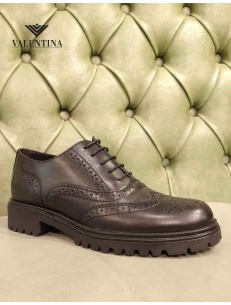- Valentina
- Shoes & Tips
- 57294 views
- men shoes, women shoes, difference

There are 3 points in which men's shoes and women's shoes differ: size, structure and style.
Size
Generally women's shoes range in Italian shoe size from 35/36 to 40/41 (occasionally 42), and men's from 40 to 45 (occasionally 46 or even 47). One might think that a woman with a size 40/41 (me, for example) can pick easily both men's and women's shoes and vice versa a man with a foot size 39 or 40 can also choose women's shoes. However that is not quite the case.
Structure: the difference is not only in the size
Not only a man is generally taller than a woman, but has also a difference in body structure and in foot structure. A man's foot tends to be wider, with a more prominent big toe, and the heel is also typically wider. Just as running shoes are very different between men and women, the fashion shoes you find in our store are also structurally different. Obviously in reference to normotypes.
Width: a size 39 for women will be narrower than a size 39 for men, and vice versa, a size 41 for men will be wider than a size 41 for women. They are therefore not interchangeable.
Instep: in general, men's feet have a higher instep, and for this reason men's shoes tend to be more roomy or to offer a lacing system that can provide more volume and therefore space. Women's feet have a more tapered shape and therefore a lower instep (usually), so women's shoes are also narrower over the foot.
Shape: men's feet (and shoes) tend to have a more rounded shape; even when the shoe is tapered, it follows a different width than a women's tapered shoe.
Unisex shoes, on the other hand, are made with a "neutral" structure that can accommodate both a female and a male foot. They generally have a wider width than women's shoes, in order to accommodate men's feet as well. This is the case of the Birkenstocks, for example, or of the Biolines: both use an insole in which the anatomy is just mentioned and it will be the foot itself that will give the "imprint" to the insole.
Style.
The difference in style and color is a matter of fashion, personal choices and taste. Also because, for example, just think of classic derby or oxford shoes that are not aesthetically distinguishable between men and women, but change in terms of internal structure.
.jpg) For example, these women's braided brogues (left) look unisex at a glance.
For example, these women's braided brogues (left) look unisex at a glance.
If we compare them with a pair of men's woven shoes (right),.jpg) apart from the style and color, we do not notice any structural difference except the length, since the women's one is a size 37, and the man a size 42, in photo. And the height of the instep, and the slightly tapered shape for women's shoes.
apart from the style and color, we do not notice any structural difference except the length, since the women's one is a size 37, and the man a size 42, in photo. And the height of the instep, and the slightly tapered shape for women's shoes.
Generally the male foot has a lower or flat foot arch, while the female foot is more accentuated. Consequently, the structure of the shoe must adapt to this, to allow greater comfort and a better fit.
Also, men's feet tend to be wider, so shoes are wider.
So a 40 size in a women's derby and a 40 size in a men's derby differ in the following points:
- the women's 40 is narrower than the men's one in the front
- the 40 for men is wider not only in the front, but also at the level of the heel
- the structure of the women's shoe takes into account a more accentuated arch.
Knowing these differences, it is also possible to choose shoes "of the other sex", that is, if a woman has a wider foot she can also opt for a men shoe, and vice versa, if a man has a narrower foot she can choose between models for women.
The same thing applies, perhaps even more rigorously to sneakers. The difference at a first glance seems to be that women's sporty shoes are more colorful and charming. There is actually a lot of difference on a structural level.
Take for example this shoe from Skechers, which looks identical for men and women, apart from the color and aesthetic details..jpg) On the left we have the women's one and on the right the men's one.
On the left we have the women's one and on the right the men's one.
.jpg)
The substantial detail is that men need shoes that are wider at the heel and narrower at the forefoot than women, for a difference in physiognomy and consequent stride, which is different between men and women.
Furthermore, in running shoes the degree of support offered in the midsole is also calculated. That is, since the muscle mass is different, the support required by the shoe is different. So usually sneakers for women have a lighter and softer midsole than men's shoes.
So, the difference is absolutely not in style or colors, but there is a structure that changes depending on whether it is a women's shoe or a men's shoe.
Even unisex shoes like the Birkenstocks have very small differences depending on whether it is a size for women or for men. So much so that they leave the choice to the customer by providing the normal fit or narrow fit option.
Birkenstock's trick is to offer an anatomical insole on which to generate the imprint of one's foot with the weight. In this way you get a personalized shoe, with the insole that responds perfectly to the shape of your foot.





